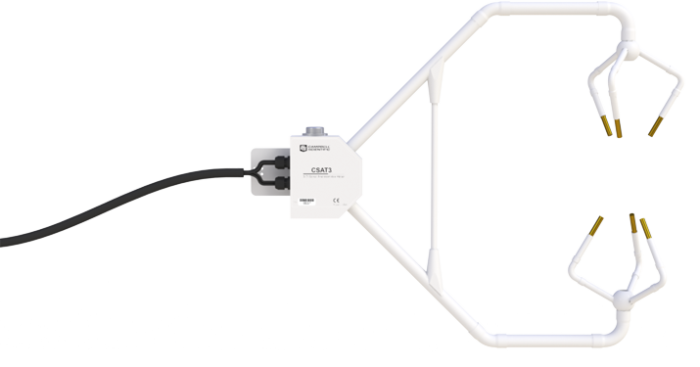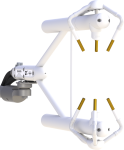This product is no longer available and has been replaced by: CSAT3B. Some accessories, replacement parts, or services may still be available.

| Services Available | |
|---|---|
| Repair | Yes |
| Calibration | Yes |
| Free Support | Yes |
Overview
The CSAT3 is a three-dimensional (3D) sonic anemometer that measures three orthogonal wind components and the speed of sound. In eddy covariance systems, it can measure the turbulent fluctuations of horizontal and vertical wind. These measurements are then used to calculate momentum flux and friction velocity. This sonic anemometer can also provide average horizontal wind speed and direction measurements. The CSAT3 comes with 7.6 M cables.
Read MoreBenefits and Features
- Provides precision turbulence measurements with minimal flow distortion
- FW05 fine wire thermocouple (12.7 μm diameter) is available as an option for fast response temperature measurements
- Withstands exposure to harsh weather conditions
- Measurements can be used to calculate momentum flux and friction velocity
- Compatible with most Campbell Scientific data loggers
Images

Technical Description
The CSAT3 has a 10 cm vertical measurement path and operates in a pulsed acoustic mode. The three orthogonal wind components (ux, uy, uz) and the speed of sound (c) are measured and output at a maximum rate of 60 Hz. Analog outputs and two types of digital outputs are provided.
Measurements can be triggered from from the CSAT3’s internal clock, the PC-generated RS-232 command, or the datalogger’s SDM command. The SDM protocol supports a group trigger for synchronizing multiple CSAT3s.
The FW05 fine wire thermocouple (12.7 μm diameter) is available as an option for fast response temperature measurements.
Compatibility
Please note: The following shows notable compatibility information. It is not a comprehensive list of all compatible products.
Dataloggers
| Product | Compatible | Note |
|---|---|---|
| 21X (retired) | ||
| CR10 (retired) | ||
| CR1000 (retired) | ||
| CR10X (retired) | ||
| CR200X (retired) | ||
| CR211X (retired) | ||
| CR216X (retired) | ||
| CR23X (retired) | ||
| CR300 (retired) | ||
| CR3000 (retired) | ||
| CR500 (retired) | ||
| CR5000 (retired) | ||
| CR510 (retired) | ||
| CR6 | ||
| CR800 (retired) | ||
| CR850 (retired) | ||
| CR850 (retired) | ||
| CR9000 (retired) | ||
| CR9000X (retired) |
Additional Compatibility Information
Data Logger Considerations
Required Operating Systems or PROMs
| Data Logger Model | Data Logger Operating System (OS) or PROMs Required |
CSAT3 OS Required |
| 21X | 1K 6145-3, 6146-5, 10006-1 | 2.1 or higher |
| 21X | 2K 6148-5, 6149-7, 6070-64 | 2.1 or higher |
| CR800, CR850 | All OS | 3.0 or higher |
| CR10 | 2K 5954-396; 4K is a Library Special |
2.1 or higher |
| CR10X | OS 1.4 or higher | 2.1 or higher |
| CR1000 | All OS | 3.0 or higher |
| CR23X | All OS | 2.1 or higher |
| CR3000 | All OS | 3.0 or higher |
| CR5000 | All OS | 3.0 or higher |
| CR9000 | 2.01 or higher | 2.1 or higher |
| CR9000X | All OS | 2.1 or higher |
Specifications
| Measurement Path Length |
|
| Path Angle from Horizontal | 60° |
| Construction | Sealed sonic transducers and electronics |
| Anemometer Head Materials | Stainless-steel tubing |
| Electronics Box Materials | Cast aluminum |
| Operating Temperature Range | -30° to +50°C |
| Voltage Supply | 10 to 16 Vdc |
| Current |
|
| Digital SDM Output Signal | CSI 33.3 k baud serial interface for data logger/sensor communication. (Data type is 2-byte integer per output plus 2-byte diagnostic.) |
| Support Arm Diameter | 1.59 cm (0.63 in.) |
| Transducer Diameter | 0.64 cm (0.25 in.) |
| Transducer Mounting Fingers Diameter | 0.84 cm (0.33 in.) |
| Cable Length | 7.62 m (25 ft) |
| Anemometer Head Dimensions | 47.3 x 42.4 cm (18.6 x 16.7 in.) |
| Anemometer Head Weight | 1.7 kg (3.7 lb) |
| Electronics Box Dimensions | 26 x 16 x 9 cm (10.24 x 6.3 x 3.54 in.) |
| Electronics Box Weight | 3.8 kg (8.4 lb) |
Measurements |
|
| Outputs |
ux, uy, uz, c (ux, uy, uz are wind components referenced to the anemometer axes; c is speed of sound.) |
| Speed of Sound | Determined from three acoustic paths; corrected for crosswind effects. |
| Measurement Rate | Programmable from 1 to 60 Hz, instantaneous measurements. Two over-sampled modes are block averaged to either 20 Hz or 10 Hz. |
| Measurement Resolution |
|
| Offset Error |
|
| Gain Error |
|
| Wind Direction Accuracy | ±0.7° at 1 m/s (for horizontal wind) |
| Rain | Innovative ultrasonic signal processing and user-installable wicks considerably improve the performance of the anemometer under all rain events. |
Digital RS-232 Output Signal |
|
| Baud Rate | 9600, 19200 bps |
| Data Type | 2-byte integer per output plus 2-byte diagnostic |
Analog |
|
| Number of Outputs | 4 |
| Voltage Range | ±5 V |
| Number of Bits | 12 |
SDM & RS-232 Digital Outputs Reporting Range |
|
| Full-Scale Wind | ±65.535 m/s autoranging between four ranges (Least significant bit is 0.25 to 2 mm/s.) |
| Speed of Sound | 300 to 366 m/s (-50° to +60°C) Least significant bit is 1 mm/s (0.002°C). |
Analog Outputs Reporting Range |
|
| ux | ±30 m s-1, ±60 m s-1 |
| uy | ±30 m s-1, ±60 m s-1 |
| uz | ±8 m s-1 |
| c | 300 to 366 m s-1 (-50 to +60°C) |
Analog Outputs LSB |
|
| ux | 15 mm s-1, 30 mm s-1 |
| uy | 15 mm s-1, 30 mm s-1 |
| uz | ±8 m s-1 |
| c | 16 mm s-1 (0.026°C) |
Related Documents
Product Brochures
Technical Papers
Downloads
CSAT3 (567 KB) 24-03-1998
PC support software for monitoring and configuring the CSAT3.Related FAQs
Number of FAQs related to CSAT3: 11
Expand AllCollapse All
-
Approximately 59.5 Hz.
-
Yes. If the matching layer is damaged or missing, return the CSAT3 to the factory for repair. Follow the steps listed on our Repair and Calibration page to request a returned material authorization (RMA) number.
-
Yes. The bubble level can be replaced in the field using pn 2842, Replacement Bubble Level G&B #2-12000.
-
With long cable lengths, monitor the SDM data collected from the CSAT3. If the CSAT3 diagnostic word is 61441 or NAN, there are SDM communications errors. If the SDM bit period is increased, SDM communications should be restored. Use the SDMSpeed() instruction to change the SDM bit period. Use the following values for the listed dataloggers:
- CR3000: 50
- CR800, CR850, or CR1000: 100
- CR5000: 90
-
Yes. The CSAT3 measurement frequency can be changed by the user. It is set by the Execution Parameter. This parameter is described in detail in the CSAT3 instruction manual in the “Datalogger Instruction Parameters” section, as well as in the “CSAT3 RS-232 Commands” section of Appendix B.
-
No. The offset is a function of temperature and time. Once a year, spot-check the CSAT3 wind offset using the procedure outlined in the CSAT3 instruction manual. If the measured offset is outside the specification, return the CSAT3 to the factory for calibration. To request a returned material authorization (RMA) number, follow the steps listed on our Repair and Calibration page.
-
The sensors used in the eddy-covariance application are not compatible with SCWin. An open-path eddy-covariance program is available for purchase as pn 18442, CRBasic Basic Eddy Covariance Program. This is the program without energy balance sensors. Also available is pn 18443, CRBasic Extended Eddy Covariance Program, with energy balance sensors. To order a custom configured program, contact an application engineer in the Micrometeorology Flux group for assistance.
-
The CSAT3 is compatible with three output signals: analog, RS-232, and Synchronous Device for Measurement (SDM). The CSAT3 can be interfaced to any data acquisition system that is compatible with analog measurements or RS-232 serial communications. SDM is used with Campbell Scientific dataloggers.
-
The CSAT3, like other sonic anemometers, measures wind speed along the sonic path using ultrasonic signals. If the salt spray blocks the sonic path, the CSAT3 will not be able to make measurements. The same is true if a thick layer of salt is deposited on the transducer faces.
-
When the CSAT3 is in need of calibration, it will set one of four diagnostic flags. Once a year, spot-check the CSAT3 wind offset using the procedure outlined in the CSAT3 instruction manual. In general, it is good practice to calibrate instruments on a regular basis, for example, every three to five years.
Case Studies
The cultivation of rice—the staple food for India, as well as for approximately half the......read more
On March 14, 2016 the European Space Agency (ESA) launched the first mission in the......read more
Understanding the exchanges of energy, water, and carbon dioxide between the atmosphere, land, and plants......read more
With instrumentation and help from Campbell Scientific, personnel from the Department of Atmospheric Sciences at......read more






